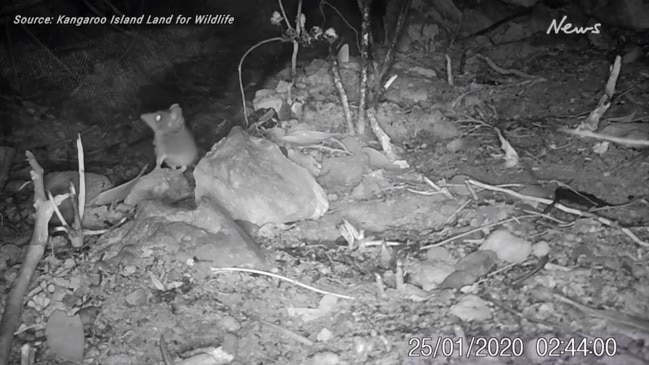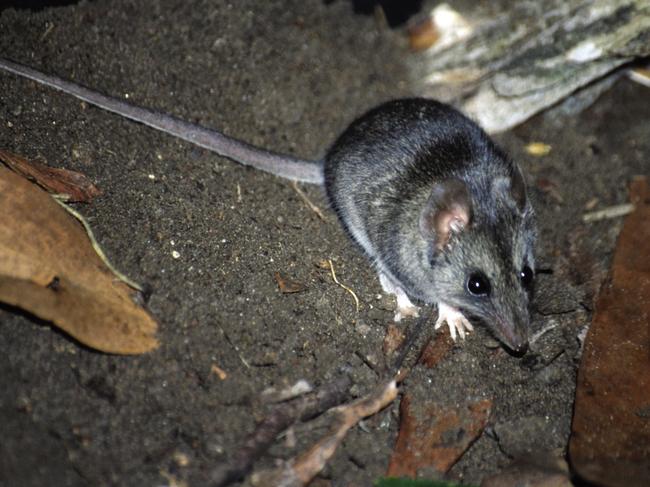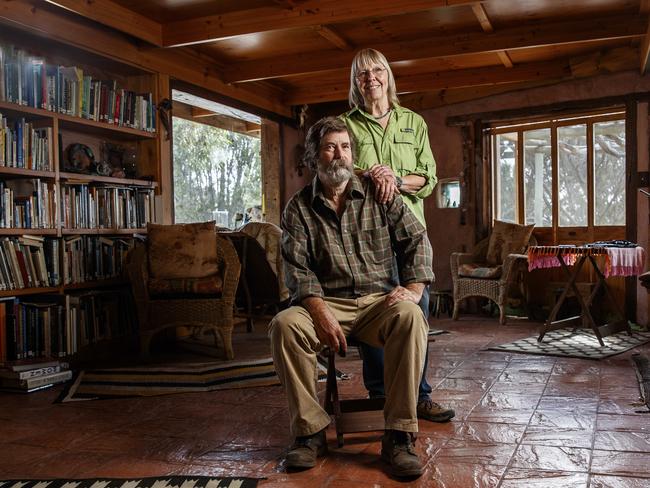Kangaroo Island bushfires: Conservationists band together to ensure Kangaroo Island’s threatened species survive
As the green shoots of regrowth gradually bring a charred Kangaroo Island landscape back to life, a dedicated band of nature lovers is working hard to ensure a wildlife population decimated by fires follows suit.

- Kangaroo Island’s threatened animal species in battle for survival
- The Advertiser +Rewards – giveaways, offers and competitions
As the sun sets over American River, conservation workers stop in their tracks to watch a female glossy black-cockatoo, perched high in a tree hollow, soak up the final rays of the day.
She’s a member of one of Kangaroo Island’s most threatened species – an animal that has been pushed even closer to extinction after three quarters of its habitat was destroyed in the island’s inferno this summer.
Mike Barth aims his scope at the bird, eager to catch a glimpse of the number on her leg band, while his colleague Torran Welz watches her admiringly. They work with the Natural Resources Management (NRM) Glossy Black-Cockatoo project, set up to stop the species’ downward spiral.
Fuelled by habitat destruction and the expansion of pastures – resulting in other threats such as the proliferation of possums, which eat the birds’ eggs – there were only 158 glossy blacks left in 1995. The project helped increase that number to about 370 before the fires devastated the island in December and January, killing thousands of animals, from insects – such as the Kangaroo Island assassin spider – to marsupials like dunnarts and koalas.

In the case of the glossy black-cockatoo project team, they prefer to take a glass half-full approach to what might seem a very bleak time for conservation on the island, which suffered losses that were almost unimaginable.
Four months after the inferno swept through, Kangaroo Island’s bushfire response has shifted from emergency to recovery mode, as the green shoots take hold in roadside reserves, bush properties and farmland across the region. The NRM team’s work has included installing nest boxes and planting sheoaks, which provide the birds’ main food source, and project officer Karleah Berris says the fires have brought home just how vital their work was to securing a future for the glossy blacks.
“If we were in the same situation (as before the project) now, we would probably be looking at extinction,” she says.
“But with the recovery program and the birds coming east, it’s made them way more resistant to the disaster.”
Berris is confident that with community support and financial backing, the species still has a good chance of survival.
“I keep thinking this population has been recovered from the brink of extinction before and we can do it again,” she says.

It is not yet known how many of the birds survived the disaster, with a species survey due in September.
“Our first concern was definitely habitat and the starvation effect,” Berris says. “But as time goes on we’re wondering how many birds were actually able to survive.”
During the cooler months, sheoaks will be planted to provide more habitat. These trees take about six years to grow and offer food for the glossy blacks.
“We’re super lucky that sheoaks are fast growing,” Berris says.
The glossy black-cockatoos are facing a battle for survival, but there’s one mammal species which has an even more desperate fight on its hands – or feet. It’s a mouse-sized marsupial that was only described as an individual species in the 1980s.
Over at Western River, in the heart of the island’s massive burn scar, fauna ecologist Pat Hodgens negotiates the bumpy road towards the region’s biggest hope of helping keep the Kangaroo Island dunnarts alive.

The cabin of the conservation worker’s car is full of telltale signs about his role – from the family-sized sunscreen container to a pile of spare camera batteries in the console, all covered by dust collected over hours spent in the field watching over the animals. There were only about 300-500 Kangaroo Island dunnarts before December – all living within the burn area. It is not known how many remain but the Environment Department estimates there would be fewer than 100.
Kangaroo Island Land for Wildlife was established a couple of years ago with the goal of preserving the species by working with landowners and eventually setting up a cat-proof fence in Western River. Hodgens said he thought the project might come crashing down to a premature end after 95 per cent of the dunnart habitat was destroyed and the project’s field cameras were melted in the blaze.
But an unburned patch provided a glimmer of hope. With the help of partners Australian Wildlife Conservancy and FAME (Foundation for Australia’s Most Endangered Species), within weeks, an exclosure was set up around the 14ha piece of land to protect the blaze’s survivors.
Plans are also afoot to set up another area alongside this refuge, and gradually create a dunnart “insurance population” by introducing other survivors found on the island. However, the COVID-19 pandemic is likely to delay this process, making it much harder to get contractors on to the island.
When SAWeekend visits, Hodgens is excited to find dunnart footage on one of the organisation’s camera traps.
“The Kangaroo Island dunnart is probably the most at-risk mammal in the country,” he says. “It could go extinct in the next few years.”
Hodgens describes the “amazing” feeling seeing the first images of dunnarts on camera footage in the days following the inferno. “It was great they were there but then we had a real sense of responsibility towards these animals – it’s a huge responsibility to do everything we can to keep them alive,” he says.
There are at least three dunnarts at the Western River refuge and the animals have also been spotted just outside that area, along with places at Snug Cove and Flinders Chase National Park – but only in very small numbers.

“There’s a lot of areas we’ve been surveying for them and found that they’re not in, so it’s still pretty dire,” Hodgens says.
A large focus has also been on catching and euthanising wild cats. KI Land for Wildlife has also established mesh tunnels covered with shadecloth to act as safe corridors for the animals within the sanctuary, so they can escape any remaining predators, including swooping birds.
Private land makes up a large portion of the conservation space on Kangaroo Island and its owners have been dealt a huge blow, losing the areas they considered sanctuaries for a plethora of species.
Among them are Fraser and Mia Vickery, whose 120-hectare heritage block at Vivonne Bay was also devastated by fire. Fraser Vickery, who previously oversaw the national parks on Kangaroo Island, the Fleurieu Peninsula and Yorke Peninsula, says the land was home to species including southern brown bandicoots, western pygmy possums and echidnas.
“I fought fires for 35 years and I knew what to expect but it’s still an emotional issue,” he says.
“You can’t come back here for probably seven years before you’ll see it almost the way it was. I was hoping there were going to be some patches left where the animals would be safe but it’s pretty clear there’s not many unburned patches.”

Measures being suggested, such as burning more regularly and zeroing in on roadside vegetation, will do little to address the real driver of this summer’s devastating fires, Vickery says.
“The big elephant in the room is climate change,” he says. “For those of us who aren’t climate change deniers, it’s pretty obvious that this has contributed to the issue.” Vickery says calls for continuous hazard reduction should be treated with caution. “If you keep burning to reduce the hazard you’re going to reduce biodiversity but, particularly in this climate change environment, a lot of fires get away. You’re trying to solve a problem but creating a major problem.”
The couple planned to build accommodation on the site but the inferno has meant the amount of time they can now spend overlooking a green oasis filled with wildlife has been drastically cut back. Already, though, there are plenty of signs of life on the devastated block, from grass trees sprouting to mallee regrowth and hakea dispersing seed. Wallabies, echidnas and goannas have also returned, looking for food.
The next biggest “shit fight”, Fraser Vickery says, will be the debate over how to deal with the island’s koala population. Introduced to the island in the 1920s, the 18 marsupials took to the region’s native vegetation and bluegum plantations with gusto.

About 50,000-60,000 of the animals were believed to be living on the island before the blazes, and that number has reduced to 5000-10,000. But there are still plenty of locals who say their population needs drastic management to stop koala numbers recovering, because of problems with the marsupials stripping trees bare. Vickery says Environment Department programs to reduce the population through sterilisation, then implanted contraceptives, were “a spectacular failure”.
“There’s no way they can keep up with the breeding of koalas. Probably two thirds of the population was still breeding,” he says.
Vickery has another fight on his hands this year: a court battle to stop Australian Walking Company building its planned accommodation to service high-end tours of the Kangaroo Island Wilderness Trail. The business – which runs similar tours in Tasmania and Victoria – has said it plans to push ahead with the project but has not announced a new time-frame for its lodges, with the track expected to be closed for about two years.

Vickery and other conservationists involved in the battle will face off against the State Government in the Supreme Court later this year, when they will argue that the State Commission Assessment Panel and Native Vegetation Council should never have approved the development.
Tony Robinson, who part-owns a bush heritage property at Karatta, near Flinders Chase National Park – an area devastated by the inferno – spoke of his heartbreak at a recent meeting of The Field Naturalists Society of SA.
“The beautiful heritage area of bushland was left a blackened and smoking ruin, along with everything in the fire’s path,” he told the society.
It featured an area which was “dunnart central”, along with nesting sites for glossy black-cockatoos.
He tells SAWeekend animals such as echidnas, wallabies, tiger snakes and goannas are now coming back, along with 10-15 bird species.
“It’s still a very dead landscape but it’s showing signs of recovery for some of the more resilient species,” Robinson says.

“The standard (plants) are all coming back from roots but there’s not much in the way of seedlings, though there’s only been one lot of decent rain since the fires. I suspect there are patches where the fire was so hot there won’t be any seeds left in the soil.”
He says while the blazes’ devastation presents an opportunity for the Environment Department to pick off the wild cats and pigs which threaten native animals, it could also be a turning point in koala management.
“The fires could be a game changer – an opportunity to transfer koalas back home,” Robinson says. “I don’t think there’s any political will to remove the koalas from Kangaroo Island. But there is a way that we could do it over a period of 10-15 years that would improve the populations in the eastern states. The whole of Kangaroo Island and Flinders Chase, in particular, (also) needs a massive injection of funding for conservation.”
Some of that money must be directed towards the insect world, says entomologist Richard Glatz, as research into invertebrates is sorely lacking.
“Chances are, by simple maths, we would have lost species (in the Kangaroo Island fires) that we did not know existed,” he says.

Glatz says the lack of funding means we had a very poor knowledge of the habitat range, population sizes, life-cycles and roles of most invertebrate species.
“It’s therefore virtually impossible to understand the impact and recovery of those species and the associated effect on the ecology,” he says.
“Scientifically, it doesn’t make sense that 95 per cent of the animals on land are insects but they only get maybe 10 per cent of the available funding for all animals.”
Glatz’s interest in the tiniest of animals began when he was a child, resulting in his MacGillivray property now housing a collection of 60,000 insects. One of the insects believed to have been affected is the Kangaroo Island assassin spider, only known from one area at Western River, which was hit by the blazes.
The spider lives in leaf litter suspended in plants.
Also affected was the carpenter bee, which had about 90 per cent of its habitat burnt on the island, and the eastern large bronze azure butterfly, which was only discovered in the region in 2014.
The larvae live in ant nests and D-day will be in November when, if they survived, the insects will pupate.
Glatz says invertebrates, often forgotten in discourse around conservation, deserve more of the spotlight as they are vital to the functioning of ecosystems.
Their role extends from pollinating plants to degrading leaf litter and regulating the populations of other species – along with feeding mammals such as dunnarts.

Ecologists Peggy Rismiller and partner Mike McKelvey have been researching Kangaroo Island’s animal populations for about 30 years. Their specialties are echidnas and Rosenberg’s goannas. About 5000 echidnas are believed to be living on the island. Avoiding the doom-and-gloom perspectives, the couple point out that there are very few species on the island that can’t be found on its unburnt eastern end.
“We see a lot of regeneration and we see a lot of good things happening,” Rismiller says at the couple’s Pelican Lagoon research centre. “It’s a new landscape and it’s a landscape about renewal, recovery and regeneration. The green shoots look amazing. We can see the roos and wallabies have been feeding on the yakkas.
“Yes, animals have been killed in the fire, but that makes core populations even stronger that can then come out again as the land regenerates.”
Since the fires, the couple has been monitoring burnt areas to study the impact on wildlife. Echidnas use ground burrows, which Rismiller says are often very well protected from fire.

“Those burrows are always very well constructed to keep temperatures very stable. The young echidnas are being weaned and coming out of the nursery burrows and we’ve discovered several of those in the fire area with young animals coming out. There was also lots of foraging from adult animals, too.”
Rosenberg’s goannas use termite mounds to lay their eggs, and despite the fire’s intensity, many of the mounds survived.
“Even in the areas where heavy fires went through we’ve seen echidnas foraging and at the plantation areas that burned fairly heavily we’ve seen lots of tracks and traces there as well,” Rismiller says.
As time goes on, she says we’ll see wildlife populations expanding alongside the regeneration of their habitat. “Nothing happens quickly – it doesn’t happen in human time,” she says.

The couple has been encouraging those affected by the fires to take photographs of how the land regenerates.
“It’s really important for the healing process of the heart and soul as well as the land,” she says.
McKelvey recalls speaking to a child who had witnessed the horrors of the inferno. “The folks were saying, right now we’re just in push forward mode – we’ve got to continue to live, we’ve got sheep to shear and we can’t worry about the future because we’re living in the now,” he says.
MORE NEWS
Animals front of mind as Kangaroo Island property goes up in flames
Kangaroo Island travel ban is off the table, police commissioner says
Kangaroo Island: RSPCA scales back wildlife feeding amid bush recovery following fires
“The children are the ones that are being impacted now, so we went for a walk with one of the kids and we showed them that there was life and there was resilience.”
He says the child finished up feeling “so much more confident and at ease”.
“They had to see the resilience that was all around them but because of their trauma they were not registering it,” McKelvey says.
“That was a really powerful thing, to see this kid draw back from the horror.”
